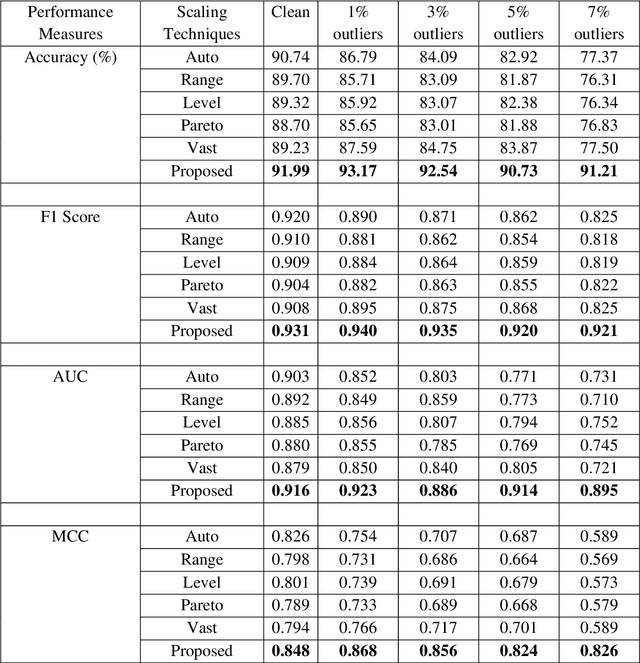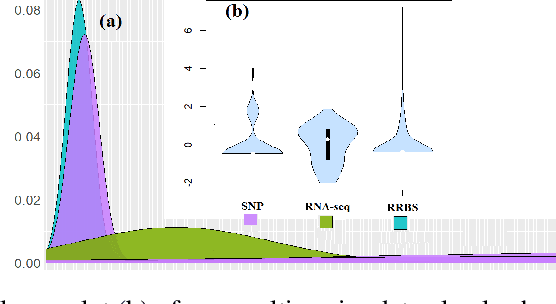Md Ashad Alam
Weighted Scaling Approach for Metabolomics Data Analysis
Aug 01, 2022



Abstract:Systematic variation is a common issue in metabolomics data analysis. Therefore, different scaling and normalization techniques are used to preprocess the data for metabolomics data analysis. Although several scaling methods are available in the literature, however, choice of scaling, transformation and/or normalization technique influence the further statistical analysis. It is challenging to choose the appropriate scaling technique for downstream analysis to get accurate results or to make a proper decision. Moreover, the existing scaling techniques are sensitive to outliers or extreme values. To fill the gap, our objective is to introduce a robust scaling approach that is not influenced by outliers as well as provides more accurate results for downstream analysis. Here, we introduced a new weighted scaling approach that is robust against outliers however, where no additional outlier detection/treatment step is needed in data preprocessing and also compared it with the conventional scaling and normalization techniques through artificial and real metabolomics datasets. We evaluated the performance of the proposed method in comparison to the other existing conventional scaling techniques using metabolomics data analysis in both the absence and presence of different percentages of outliers. Results show that in most cases, the proposed scaling technique performs better than the traditional scaling methods in both the absence and presence of outliers. The proposed method improves the further downstream metabolomics analysis. The R function of the proposed robust scaling method is available at https://github.com/nishithkumarpaul/robustScaling/blob/main/wscaling.R
A robust kernel machine regression towards biomarker selection in multi-omics datasets of osteoporosis for drug discovery
Jan 13, 2022



Abstract:Many statistical machine approaches could ultimately highlight novel features of the etiology of complex diseases by analyzing multi-omics data. However, they are sensitive to some deviations in distribution when the observed samples are potentially contaminated with adversarial corrupted outliers (e.g., a fictional data distribution). Likewise, statistical advances lag in supporting comprehensive data-driven analyses of complex multi-omics data integration. We propose a novel non-linear M-estimator-based approach, "robust kernel machine regression (RobKMR)," to improve the robustness of statistical machine regression and the diversity of fictional data to examine the higher-order composite effect of multi-omics datasets. We address a robust kernel-centered Gram matrix to estimate the model parameters accurately. We also propose a robust score test to assess the marginal and joint Hadamard product of features from multi-omics data. We apply our proposed approach to a multi-omics dataset of osteoporosis (OP) from Caucasian females. Experiments demonstrate that the proposed approach effectively identifies the inter-related risk factors of OP. With solid evidence (p-value = 0.00001), biological validations, network-based analysis, causal inference, and drug repurposing, the selected three triplets ((DKK1, SMTN, DRGX), (MTND5, FASTKD2, CSMD3), (MTND5, COG3, CSMD3)) are significant biomarkers and directly relate to BMD. Overall, the top three selected genes (DKK1, MTND5, FASTKD2) and one gene (SIDT1 at p-value= 0.001) significantly bond with four drugs- Tacrolimus, Ibandronate, Alendronate, and Bazedoxifene out of 30 candidates for drug repurposing in OP. Further, the proposed approach can be applied to any disease model where multi-omics datasets are available.
A generalized kernel machine approach to identify higher-order composite effects in multi-view datasets
Apr 29, 2020



Abstract:In recent years, a comprehensive study of multi-view datasets (e.g., multi-omics and imaging scans) has been a focus and forefront in biomedical research. State-of-the-art biomedical technologies are enabling us to collect multi-view biomedical datasets for the study of complex diseases. While all the views of data tend to explore complementary information of a disease, multi-view data analysis with complex interactions is challenging for a deeper and holistic understanding of biological systems. In this paper, we propose a novel generalized kernel machine approach to identify higher-order composite effects in multi-view biomedical datasets. This generalized semi-parametric (a mixed-effect linear model) approach includes the marginal and joint Hadamard product of features from different views of data. The proposed kernel machine approach considers multi-view data as predictor variables to allow more thorough and comprehensive modeling of a complex trait. The proposed method can be applied to the study of any disease model, where multi-view datasets are available. We applied our approach to both synthesized datasets and real multi-view datasets from adolescence brain development and osteoporosis study, including an imaging scan dataset and five omics datasets. Our experiments demonstrate that the proposed method can effectively identify higher-order composite effects and suggest that corresponding features (genes, region of interests, and chemical taxonomies) function in a concerted effort. We show that the proposed method is more generalizable than existing ones.
Identifying Outliers using Influence Function of Multiple Kernel Canonical Correlation Analysis
Jun 01, 2016



Abstract:Imaging genetic research has essentially focused on discovering unique and co-association effects, but typically ignoring to identify outliers or atypical objects in genetic as well as non-genetics variables. Identifying significant outliers is an essential and challenging issue for imaging genetics and multiple sources data analysis. Therefore, we need to examine for transcription errors of identified outliers. First, we address the influence function (IF) of kernel mean element, kernel covariance operator, kernel cross-covariance operator, kernel canonical correlation analysis (kernel CCA) and multiple kernel CCA. Second, we propose an IF of multiple kernel CCA, which can be applied for more than two datasets. Third, we propose a visualization method to detect influential observations of multiple sources of data based on the IF of kernel CCA and multiple kernel CCA. Finally, the proposed methods are capable of analyzing outliers of subjects usually found in biomedical applications, in which the number of dimension is large. To examine the outliers, we use the stem-and-leaf display. Experiments on both synthesized and imaging genetics data (e.g., SNP, fMRI, and DNA methylation) demonstrate that the proposed visualization can be applied effectively.
 Add to Chrome
Add to Chrome Add to Firefox
Add to Firefox Add to Edge
Add to Edge